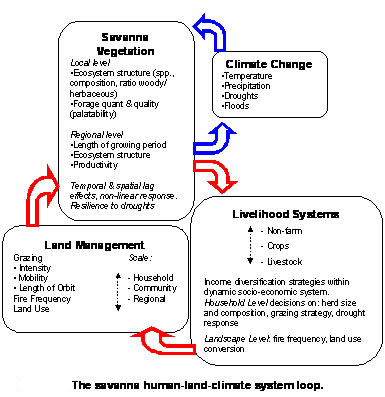
| | Home | | Research | | People | | Publications | | Teaching Materials | | Login |
ResearchOverviewA key to estimating the impacts of climate change on ecosystems and human well-being in dry ecosystems is understanding how climate change affect the habitat of livestock, wildlife and other organisms. Unfortunately, our understanding of the determinants of savanna vegetation structure largely ignores land use, which may explain why our best regional models of savanna vegetation structure show weak correlations, even with rainfall. We propose to conduct empirical analyses to develop models with more explanatory power by including land use and land management history, wood fuel collection, fire history and other variables to explain structure at specific sites. Climate change also affects vegetation dynamics. The early results of the statistical analysis of meteorological data and climate modeling being conducted by our NSF funded CLIP project indicate that warmer temperatures and higher potential evapotranspiration, combined with variable precipitation may already be lowering the productivity of much of the East African savanna. The ultimate impact of this climate change on vegetative productivity and species composition, and thus on wildlife and domestic livestock, is as yet unknown. |
Conceptual Diagram
|
Research Questions
The overarching research question of the project is: What are the key characteristics of and dynamics between coupled human-biophysical systems in the East African savannas under climate change?
The sub-research questions addressing the components and linkages, include:
-
How does savanna vegetation respond to a changing climate? Sub-questions include the possible changing resilience or response by vegetation to drought, if or when there are tipping points of change to new state (new savanna biome), and whether the ecosystem’s response to climate change is nonlinear as hypothesized.
-
What are the combinatory effects of human land management and climatic change impacts on savanna vegetation? Sub-questions include: long versus short-term processes and impacts, scale effects, and the impact on land of human response to drought.
-
Does land management have a sufficiently large impact on savanna vegetation to alter the local or regional climate? Sub-questions include the extent and intensity of land management change required to impact climate, and whether the effect is temporary or leads to a new state.
-
How are livelihood systems of pastoralists and agro-pastoralists responding to climate change in the context of the evolving socioeconomic systems? Sub-questions include what is the role of societal differentiation on resilience and response to drought and to climate change, how does the role of livestock change, and how do vulnerability and coping strategies to drought evolve.
Addressing these questions will contribute to scientific questions in climate, ecological and social science, and particularly to our ability to understand and analyze the interaction of social and biophysical systems.
